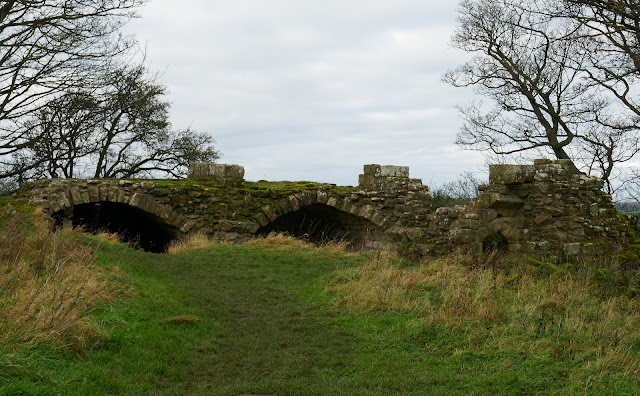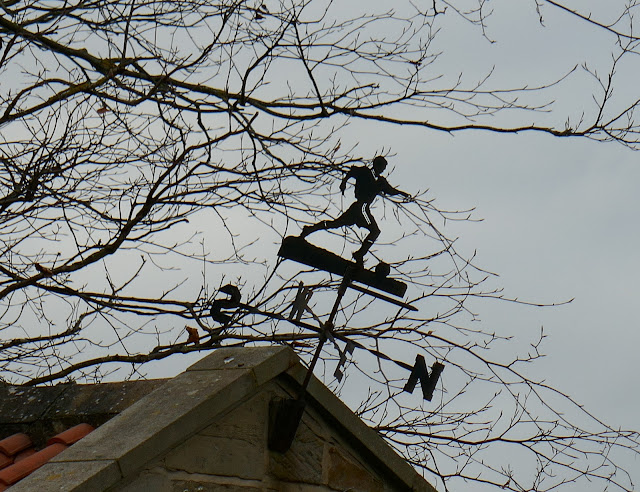Whorlton Castle and Church from Swainby
6 miles Dry and chilly
We parked the cars in the road at Swainby near the Blacksmith's Arms and before crossing the river we looked at the restored pinfold just opposite the pub. A pinfold is where stray animals were kept secure until they were reclaimed by their owners after payment of a fine.
Today's walk from The Walker's Guide to the Cleveland Hills
Swainby High Street
The Pinfold
We then walked up the high street and turned left past the Blacksmith's Arms and into a footpath just before the church.
This footpath passes along the back of houses with a park to the left and a small stream to the right of the path.
Miner weather vane
Turn off the road at the footpath sign...
... and follow the narrow path behind houses
The path quickly leaves Swainby, which Tom Scott Burns informs us means 'Swain's Farm', from the old Norse name Sveinn, and joins a lane which takes one very quickly to the site of Whorlton Castle.
TSB tells us that there have been a number of castles on this site, even before the Domesday Book which records it as Wirueltun in 1086. William the Conqueror gave the manor to Robert Count de Mortain, and then it passed into the hands of the de Meynell family. The castle was surrounded by a deep moat over which was a drawbridge. In 1323 Edward II was known to have stayed at Whorlton Castle while hunting deer in North Yorkshire and during the Cromwellian period Royalists held the castle and were bombarded by Roundheads from Whorl Hill to the East and Toft Hill to the West.
We were pleased to see the castle gatehouse was unlocked, unlike our last visit, and we were able to enter for a look around.
Rear gate of the gatehouse with the Keep behind
Remains of the Keep
Clive's blue glove waves from the upper window
Access can be gained to the upper storey
We had a good look round and then walked a few yards further along the tarmac lane to the old Saxon church of Holy Cross. There is a tale that an underground passage links the castle to this nearby church and we decided to stop off to have a look round. The church was locked and we peered through the grill in the chancel door. We could just see the bog oak effigy of the second Lord Nicholas de Meynell who died in 1322, as described by TSB. Bog oak has a significantly higher density and hardness than ordinary oak and was created when prehistoric forests were submerged under water and silt in anaerobic conditions thousands of years ago. Hence the statue still look as good as the day it was made.
There are some very interesting tombstones dating from the early 1700s.
Holy Cross Church
| 'In perfect hilth he went from home, and little thought his glass was run, but dying in so short a space, I hope his soul in a good place' |
Rear of Holy Cross Church
Bog oak effigy of Lord De Meynell
On the rear wall are two shields with coats of arms. One is nearly illegible but the other with three hands is the coat of arms of Bate of Easby.
Walking round to the rear of the church we noticed a medieval 'Mass Dial'. In days when the majority of people were illiterate these would be sited on the south wall of a church and a wooden peg (called a gnomon) would have been placed in the top hole. The Mass Dial worked as a sun dial, the shadow reaching a peg in one of the bottom holes would indicate the approximate times for mass.
Returning to the front of the church we noticed a WW2 headstone and were saddened by the obvious implication of the dates on the adjoining memorial stone.
We returned to the lane and followed it to the junction with Whorlton Lane, where we climbed a stile into fields and headed straight towards Whorl Hill, which dominates the skyline.
 |
| Whorl Hill Farm |
Leaving Whorlton Lane
Texel Ram relaxing in field of sheep. "My work is done."
Climbing Park Hill
Looking back at the church and castle
Looking down on Goulton Home and free range hens.
Whorl Hill Farm
A steady climb took us into the trees of Whorl Hill (old Norse 'hvirfill' - 'high hill with a rounded top') and we continued to climb until our track levelled out and we circumnavigated the hill, just inside the tree line.
TSB informs us that in 1810 one of Britain's largest hoards of Roman silver coins (weighing 2 stones) was dug up on Whorl Hill by a local farmer whilst ploughing his field.
We followed the path with a fine view down to Swainby through the trees, until we dropped away from the main path to exit the woods at Bank Lane via the garden of a bungalow.
Climbing Whorl Hill
Circumnavigating Whorl Hill
Walking towards High Farm on Bank Lane
We now walked up Bank Lane towards Live Moor and Round Hill.
Reaching the trees of Faceby Plantation a short sharp climb brought us to a path below Round Hill, and here we sat to enjoy our coffee and scones.
We now climbed once more, to reach the moor top and the stone path of the Cleveland Way. We turned right and walked into a head wind, soon passing a large cairn standing on a Bronze Age burial mound.
Looking back at Whorl Hill from our climb to Whorlton Moor
Roseberry to our left as we climb
Bronze Age cairn
We followed the Cleveland Way footpath westwards with good views down to Whorl Hill and Swainby to our right, eventually reaching the steep descent to Huthwaite Green.
This steep descent is always slippery and requires care. At the bottom where the path reaches Scugdale Lane is an old railway goods truck, a remnant of the mineral railway that once ran up this valley into Scugdale. Someone has used the truck as a firewood store.
We crossed the lane and passed Hollin Hill Farm and then crossed two bridges over meandering Scugdale Beck to enter fields where a faint track took us to the trees of Clain Wood.
On the Cleveland Way
Whorl Hill showing old spoil tips and lakes
Passing through the moor gate
... and dropping down to Scugdale
Highland cattle at Huthwaite Green
Handsome is as handsome does
Old railway truck
Ford over Scugdale Beck
Climbing towards Clain Wood
Climbing to Clain Wood we saw there had obviously been extensive logging operations recently and the wood was looking rather battered.
We followed the Cleveland Way through the woods, at times walking parallel with the dismantled railway, until we reached the tarmac of Coalmire Lane.
We reach what used to be Clain Wood
Clive looks down to the dismantled railway
Looking over Scugdale to Whorl Hill
New sign near Coalmire Lane
Here we turned right to follow the tarmac downhill to Swainby, following the road and spotting a couple of favourite weather vanes as we entered the village.
We passed by the new Church of Holy Cross in Swainby, which was built around 1875- 1877, to replace the old church at Whorlton, and then traipsed sadly past the Black Horse, where we would normally have ended our walk in happier, plague free days.
We crossed the river and returned to our cars. This is a nice winter walk with plenty of variation.



























































Wow, thank you for this! Nicholas de Meynells is one of my ancestors, my mums maiden name is Meynell and her dad, my grandad, once told her about Whorlton Castle belonging to the Meynells. I have just started researching this and I’m finding out alsorts so thank you for you post!
ReplyDelete